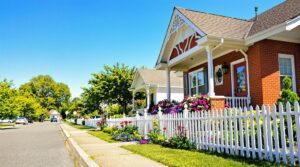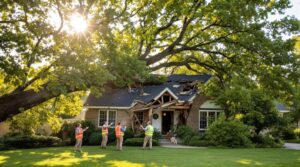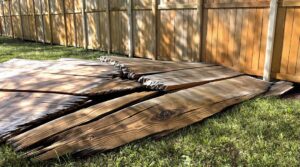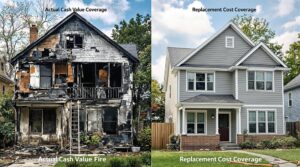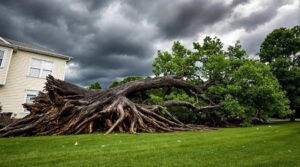Homeowners insurance typically covers fence damage under the "other structures" portion of the policy, with coverage limits usually ranging from 40% to 70% of the main dwelling coverage. Insurance protects against specific perils including storms, fallen trees, vandalism, and fire damage. However, wear and tear, poor maintenance, and certain natural disasters like floods are generally excluded. Proper documentation and prompt reporting are essential for successful claims, and understanding the full scope of coverage reveals important details about protection and limitations.
Key Takeaways
- Homeowners insurance typically covers fence damage from severe weather, including wind, hail, lightning strikes, storms, and fire.
- Fences fall under "other structures" coverage, with limits between 40-70% of the main dwelling coverage amount.
- Insurance excludes fence damage from normal wear and tear, poor maintenance, floods, earthquakes, and pest infestations.
- Damage from fallen trees is usually covered, whether it's your tree or a neighbor's tree during a storm.
- Criminal activities like vandalism and theft of fence materials are covered under standard homeowners insurance policies.
Common Types of Fence Damage Covered by Insurance
Property owners can rely on homeowners insurance to cover several common types of fence damage. When severe weather strikes, insurance typically covers wind-related incidents, storm damage from hail and lightning, and trees that fall onto fence materials during natural events.
Fire damage to fencing structures is also included in standard coverage, regardless of the ignition source.
Insurance protection extends to criminal activities affecting fences, including vandalism and theft of fence materials.
While repair options may vary depending on the extent of the damage, insurance companies generally assess claims based on photographic evidence and documentation.
In situations where a neighbor's tree damages the fence during a storm, the property owner's insurance typically provides coverage.
However, if there is evidence that the neighbor's tree was diseased or poorly maintained before falling, the property owner may have recourse to seek compensation through the neighbor's insurance policy instead.
Understanding Your Policy's Coverage Limits
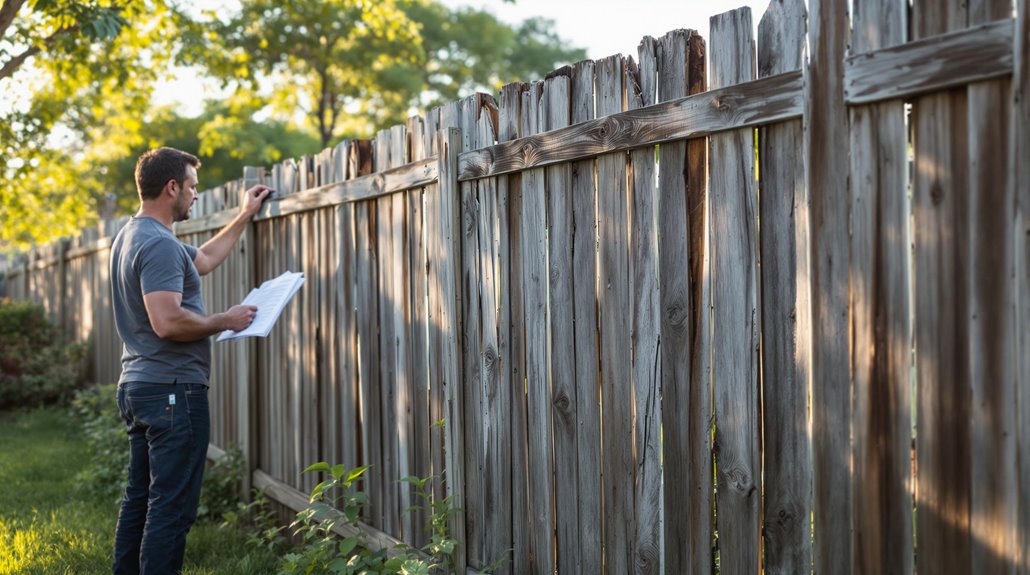
When reviewing homeowners insurance policies, understanding coverage limits for fences requires careful attention to the percentage allocations within the policy structure.
Most policies categorize fences under "other structures" coverage, which typically ranges from 40% to 70% of the main dwelling coverage limit, though some policies may offer as little as 10%.
Insurance policy reviews reveal that coverage limits are determined by multiple factors, including the property's location, size, and overall value.
When considering fence replacement costs, homeowners must account for their policy's deductible, which must be met before coverage takes effect. The financial practicality of filing a claim depends on whether repair costs exceed the deductible amount.
Additionally, specific types of damage may be excluded from coverage, such as normal wear and tear. Policyholders should carefully evaluate their coverage limits and consult with insurance providers to guarantee adequate protection for their fencing structures.
When Insurance Won't Cover Fence Damage
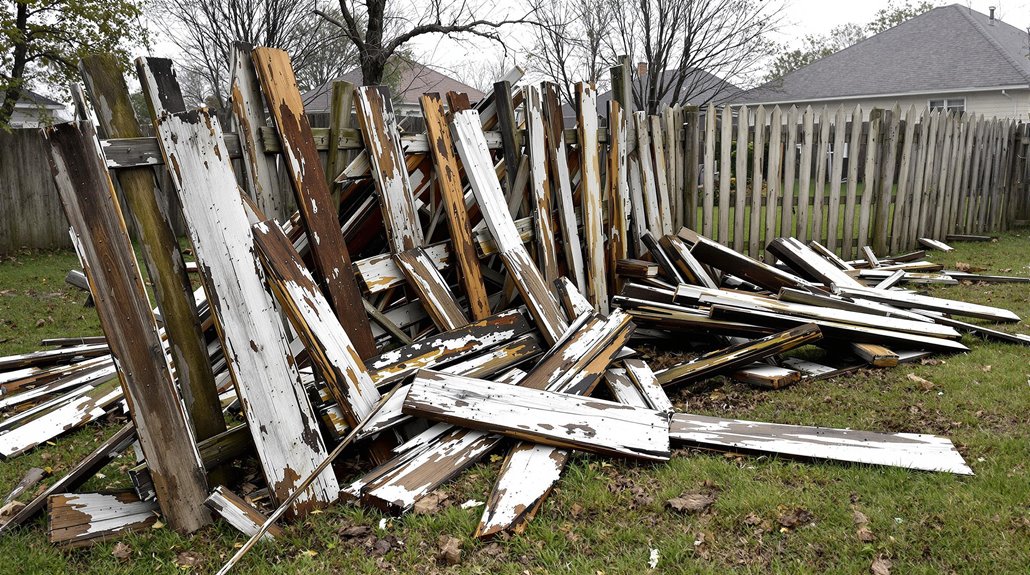
Homeowners insurance typically excludes coverage for fence damage resulting from normal wear and tear, including gradual deterioration and aging of materials.
Insurance companies also deny claims when property owners have demonstrated poor maintenance practices or neglected necessary repairs over time.
While standard policies may cover sudden and accidental damage, they generally exclude damage from natural disasters like floods and earthquakes unless specific additional coverage has been purchased.
Normal Wear and Tear
The standard homeowners insurance policy draws a clear line between sudden, unexpected events and normal deterioration of fences over time.
Insurance providers consistently exclude coverage for damage resulting from gradual wear, which impacts fence longevity through issues like wood rot, rust, and general aging.
A proper wear assessment reveals common exclusions that homeowners should anticipate. These include damage from mold and fungus growth, termite infestations, and the cumulative effects of weather exposure such as sun damage and moisture.
Regular maintenance is essential since insurers expect property owners to prevent deterioration through proper upkeep. Damage caused by lack of maintenance, natural settling of the ground, or gradual environmental factors falls squarely within the category of wear and tear, leaving homeowners responsible for repairs and replacements.
Poor Maintenance History
Most insurance providers explicitly exclude coverage for fence damage stemming from inadequate maintenance, creating significant financial implications for property owners who neglect regular upkeep.
Poor maintenance history often leads to insurance denial when damage occurs from mold, fungus, or termite infestations. Additionally, insurers will not cover repairs if a fence collapses under its own weight due to deterioration or falls into disrepair through neglect.
Insurance companies are particularly strict about damages resulting from defective materials, faulty construction methods, or long-term deterioration.
When property owners fail to address known issues or perform routine maintenance, they risk losing coverage for any subsequent damage.
To maintain valid insurance protection, homeowners must demonstrate consistent care and promptly address maintenance issues that could compromise the fence's structural integrity.
Natural Disasters Effects
Beyond routine maintenance concerns, natural disasters present a complex set of coverage limitations for fence damage under standard homeowners insurance policies.
While damage from tornadoes and windstorms typically receives coverage, other natural disaster impacts may leave homeowners financially vulnerable without proper natural disaster preparedness.
Standard policies generally exclude flood-related fence damage, earthquake damage, and damage from volcanic eruptions. Properties in high-risk areas often require supplemental coverage to protect against extreme weather impacts.
Additionally, even when coverage exists, special considerations like hurricane deductibles may apply, which can be substantially higher than standard deductibles.
Land subsidence and earthquake-induced landslides also fall outside typical coverage parameters. Understanding these exclusions is essential for homeowners to guarantee adequate protection through appropriate supplemental insurance options.
Filing a Successful Fence Damage Claim
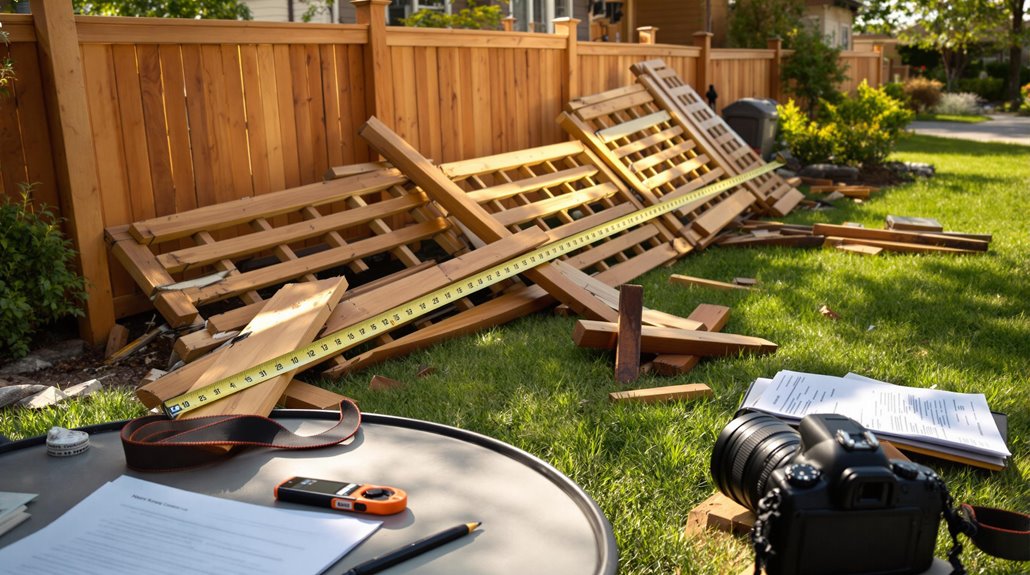
When fence damage occurs, filing a successful insurance claim requires careful attention to documentation and proper procedure. A thorough fence inspection and detailed claim documentation, including clear photographs from multiple angles, should be completed before any repairs begin. Insurance providers rely heavily on visual evidence to assess damage and determine coverage.
| Claim Filing Steps | Required Documentation | Important Considerations |
|---|---|---|
| Contact Insurance | Photos of Damage | Deductible Amount |
| Complete Forms | Maintenance Records | Policy Coverage Limits |
| Meet Adjuster | Repair Estimates | Premium Impact |
Before initiating a claim, homeowners should evaluate whether repair costs exceed their deductible and consider the potential impact on future premiums. If proceeding with a claim, policyholders should contact their insurance provider promptly, providing essential details about the incident and property location. The claims process typically involves submitting formal documentation, obtaining repair estimates, and meeting with an adjuster who will assess the damage and determine coverage based on policy terms.
Dealing With Neighbor-Related Fence Issues
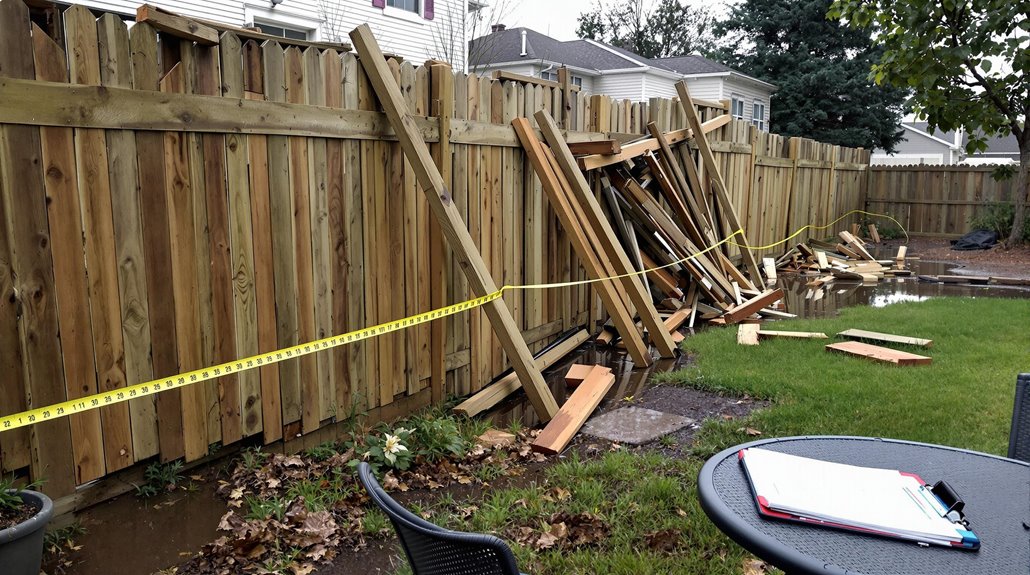
When a neighbor's tree falls and damages a fence, homeowners can file a claim with their insurance company under the "other structures" coverage of their policy.
Insurance companies typically cover fence damage from fallen trees due to storms or natural disasters, regardless of tree ownership.
If the tree fell due to the neighbor's negligence or poor maintenance, the insurance company may pursue subrogation against the neighbor's insurance to recover costs.
Neighbor's Tree Falls Down
Although homeowners may feel uncertain about insurance coverage when a neighbor's tree damages their fence, standard homeowners insurance policies typically cover such incidents if they result from covered perils like storms or strong winds.
The affected homeowner should file a claim with their own insurance company, regardless of tree ownership, and document the damage with photographs for the claims adjuster.
Insurance companies may seek reimbursement from the neighbor's insurer if negligence contributed to the tree's fall. However, coverage can be denied if the tree fell due to poor maintenance or neglect.
While tree root damage often requires neighbor communication to resolve, storm-related fence damage is generally covered under the "other structures" portion of the policy, subject to deductibles and coverage limits.
Shared Fence Repair Responsibility
Dealing with shared fence repair responsibilities requires clear understanding of both legal obligations and insurance coverage limitations.
When it comes to fence maintenance, homeowners must recognize that damage resulting from neglect typically isn't covered by insurance policies. Regular upkeep is essential to maintain coverage eligibility.
Insurance companies generally cover fence damage caused by storms or accidents under the "other structures" portion of policies.
However, determining shared responsibility becomes vital when damage occurs. If one neighbor's actions cause the damage, their insurance may be liable.
To prevent disputes, homeowners should conduct regular inspections, maintain documentation of upkeep efforts, and communicate clearly with neighbors about maintenance responsibilities.
This proactive approach helps avoid costly repairs and potential claim denials due to negligence.
Calculating Deductibles and Reimbursement
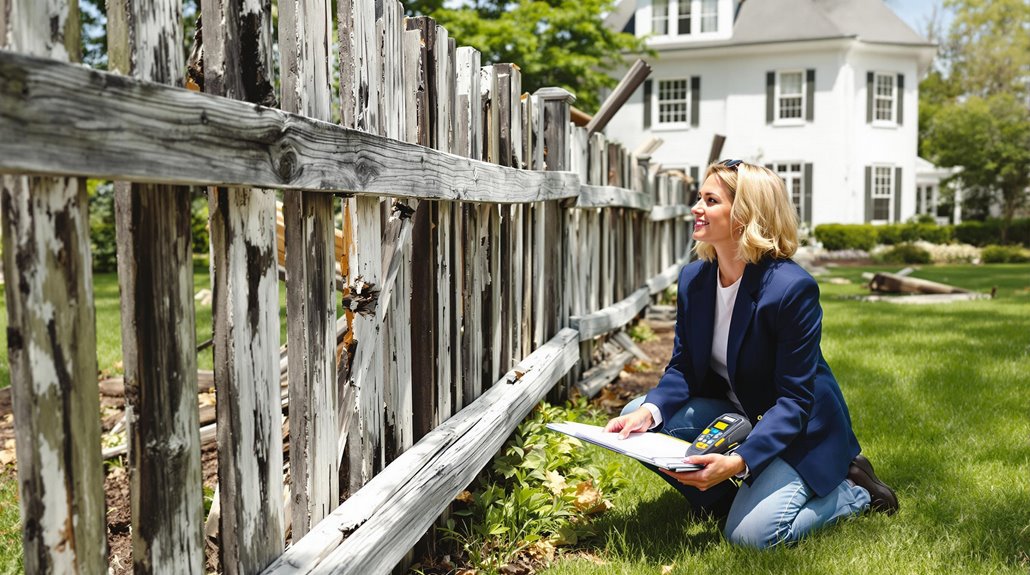
Understanding deductibles and reimbursement calculations is essential for homeowners seeking fence coverage through their insurance policies.
Insurance companies typically offer two deductible types: standard fixed-amount deductibles ranging from $500 to $2,000, and percentage-based deductibles for specific events like wind or hail damage, calculated at 1% to 10% of the home's insured value.
The reimbursement process begins after the homeowner pays the applicable deductible. Coverage for fences falls under the "other structures" category, which usually provides protection up to 10% of the home's insured value.
For example, a home insured for $400,000 would have up to $40,000 available for structures like fences. When filing a claim, homeowners should document the damage thoroughly with photos and videos.
An insurance adjuster then evaluates the damage to determine whether repair or replacement is necessary, ultimately establishing the final reimbursement amount within policy limits.
Evidence Requirements for Fence Claims
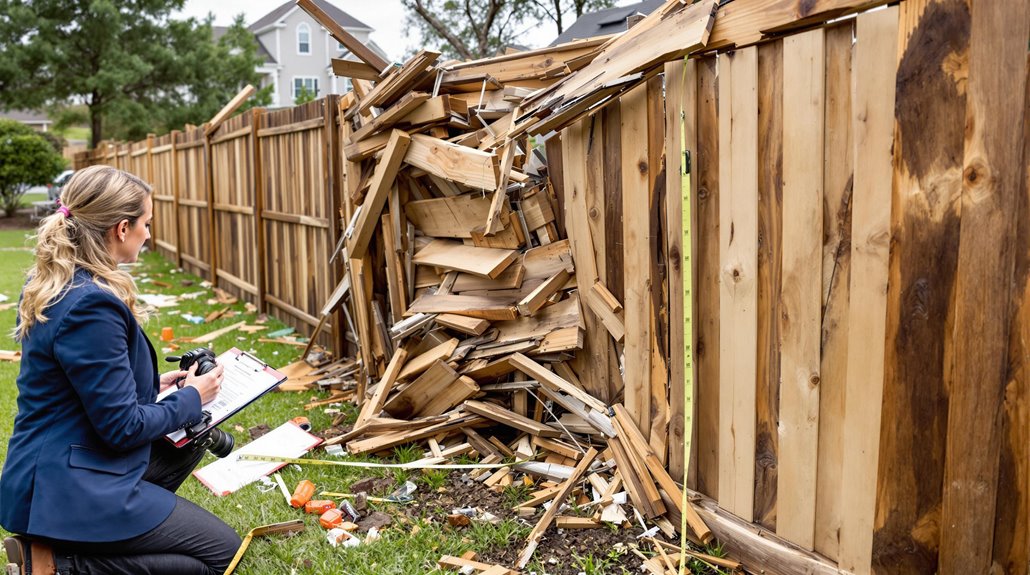
Once homeowners determine their deductible and coverage limits, gathering proper evidence becomes the foundation of a successful fence claim. Insurance companies require thorough documentation to process claims efficiently.
Immediate action is vital, as claim deadlines often apply, and evidence must be collected before repairs begin. A detailed fence inspection by an adjuster typically follows the initial claim filing.
Essential documentation must include:
- Detailed photographs and videos showing the damage from multiple angles
- Written estimates from qualified contractors for repair costs
- Police reports if vandalism or criminal activity is involved
- Expert assessments, such as arborist reports for tree-related damage
The submission process requires organizing all evidence systematically, including receipts from the original fence installation and any previous repairs.
Insurance companies evaluate claims based on the quality and completeness of documentation provided. Maintaining proper records throughout the process helps guarantee fair compensation and timely claim resolution.
How Fence Claims Affect Insurance Rates

Filing a fence claim can greatly impact homeowners insurance rates, as insurers carefully evaluate each claim to assess risk and adjust premiums accordingly.
When homeowners submit multiple claims, insurers often view this increased claim frequency as a sign of higher risk, potentially leading to significant premium increases.
The extent of rate adjustments depends on several factors, including the type of damage, repair costs, and coverage limits.
Storm or fire-related damages may affect rates differently than maintenance issues. Additionally, claims that approach policy limits typically result in steeper premium increases.
While changing insurance providers might seem like a solution, claim history follows policyholders across companies.
To maintain stable rates, homeowners should consider their deductible amount before filing claims, as smaller claims may not justify potential long-term premium increases.
Insurance companies review claims history during policy renewals, making it vital to weigh the immediate benefit of filing a claim against future rate implications.
Maintaining Your Fence to Prevent Claims
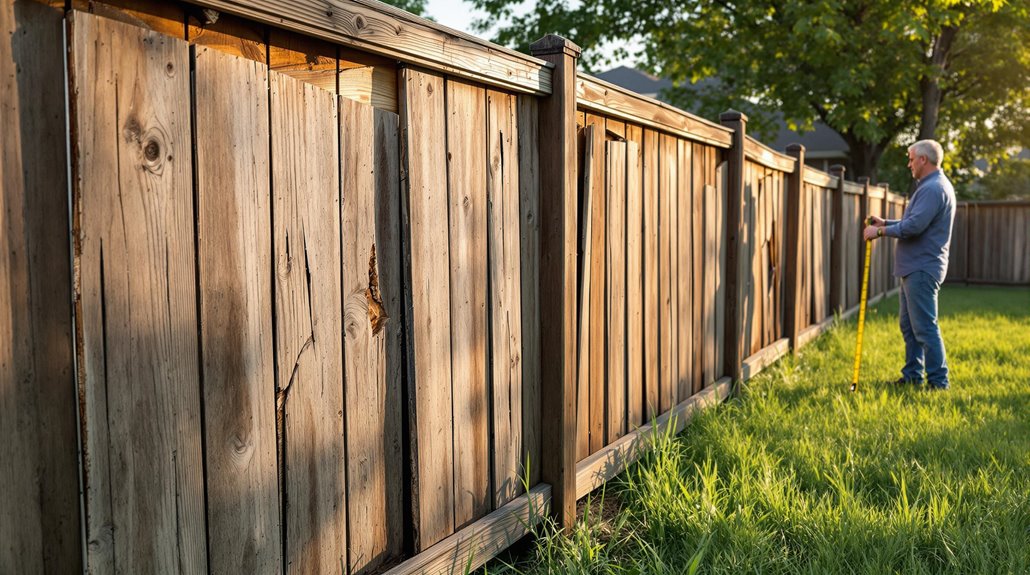
Proper fence maintenance plays an essential role in preventing insurance claims and protecting homeowners' investments. Regular fence inspections and a consistent maintenance schedule help identify potential issues before they escalate into costly problems.
Insurance companies often scrutinize maintenance records when processing claims, making proper upkeep vital for coverage approval.
Key maintenance practices include:
- Conducting monthly visual inspections to detect signs of damage or deterioration
- Applying protective coatings and treatments according to manufacturer specifications
- Removing vegetation growth and addressing rust or corrosion promptly
- Documenting all maintenance activities and repairs with dates and photographs
Neglecting fence maintenance can lead to claim denials and increased repair costs. Professional servicing may be necessary for complex repairs, while routine tasks can often be managed by homeowners.
Frequently Asked Questions
Can I Choose My Own Contractor for Fence Repairs After Insurance Approves?
Homeowners typically maintain the right to select their preferred contractor during the insurance claim procedures, though some insurers may require the chosen contractor to meet specific approval process requirements.
Will Insurance Cover Upgrading My Fence to Meet New Building Codes?
Like a blueprint guiding construction, standard homeowners insurance typically won't cover fence compliance upgrades unless specifically added through an ordinance or law endorsement to meet new building codes.
How Long Do I Have to File a Fence Damage Claim?
Claim timelines vary by insurance provider, typically ranging from 24 hours to several months. Policyholders should review their specific policy for filing deadlines and report damage promptly to avoid claim denials.
Does Insurance Cover Temporary Fencing While Repairs Are Being Made?
Like clockwork gears, insurance typically covers temporary fence coverage during legitimate repairs, though policies often include repair duration limits and may require pre-approval from the insurance provider.
Will My Insurance Cover Decorative Elements or Custom Features on Fences?
Homeowners insurance typically covers decorative fences and fence enhancements if damaged by covered perils. Coverage falls under "other structures" at 10% of home's value, excluding wear and tear or maintenance issues.
Final Thoughts
Understanding homeowners insurance coverage for fences isn't always a walk in the park, but knowledge is essential for protecting this valuable property asset. By maintaining proper documentation, understanding policy limits, and performing regular maintenance, homeowners can navigate fence-related claims successfully. Whether dealing with storm damage or neighbor disputes, being well-informed about coverage options and claim procedures guarantees the best possible outcome when fence damage occurs.
For homeowners dealing with fence damage or any other property damage claims under their homeowners insurance policy, insurance industry professionals and legal experts strongly advise consulting a qualified state-licensed public adjuster. Public adjusters work exclusively for policyholders, not insurance companies, serving as dedicated advocates throughout the claims process. These state-licensed professionals help policyholders understand their policy coverage, identify hidden damages often unknown to property owners, thoroughly document losses, and negotiate with insurance companies to secure fair settlements while protecting policyholders' legal rights.
By engaging a public adjuster, homeowners can maximize their claim payouts, expedite the claims process, and reduce the stress of dealing with insurance companies. Policyholders interested in discussing their property damage or loss claims can request a no-obligation free consultation with a Public Claims Adjusters Network (PCAN) member public adjuster through our contact page.
